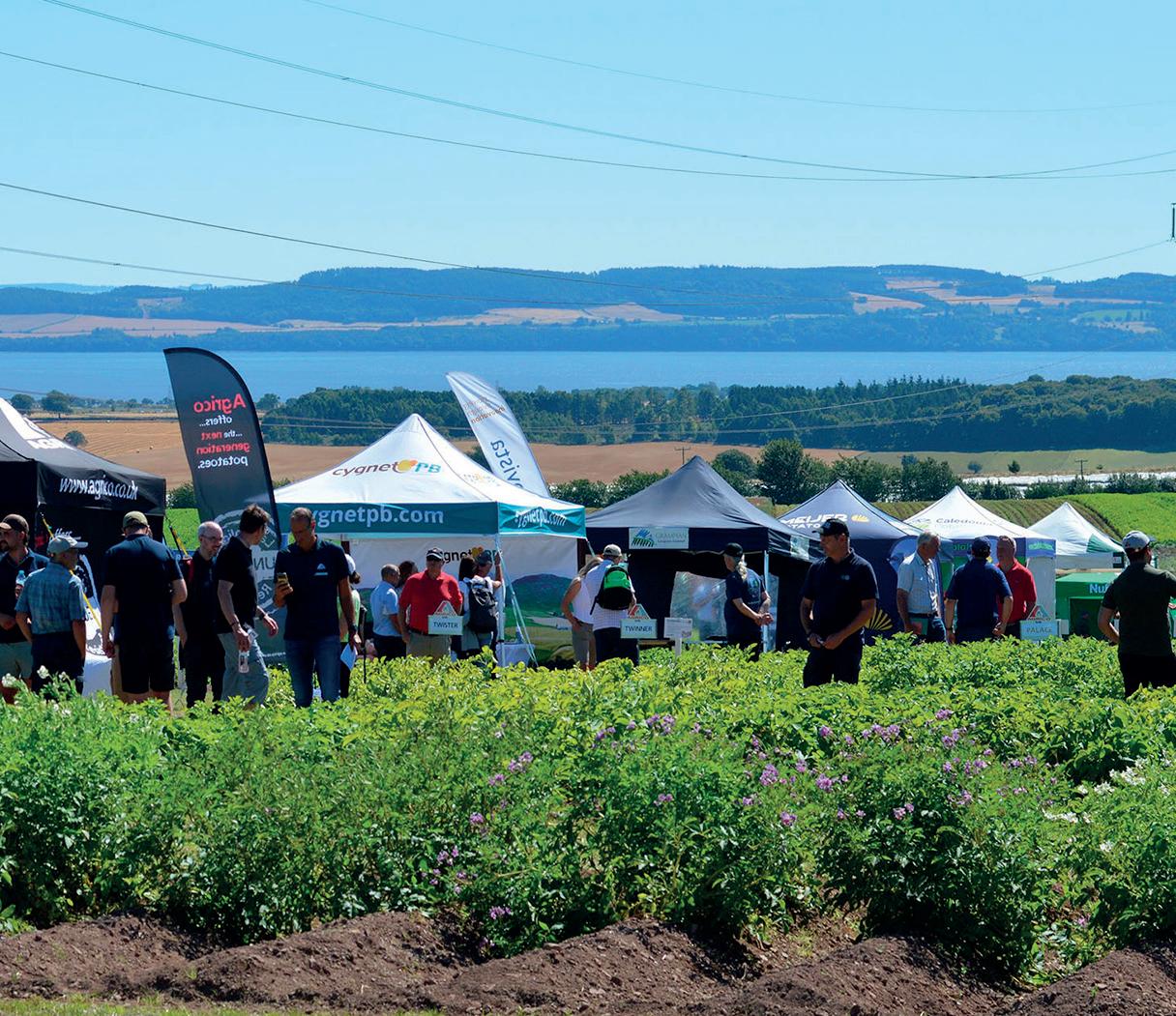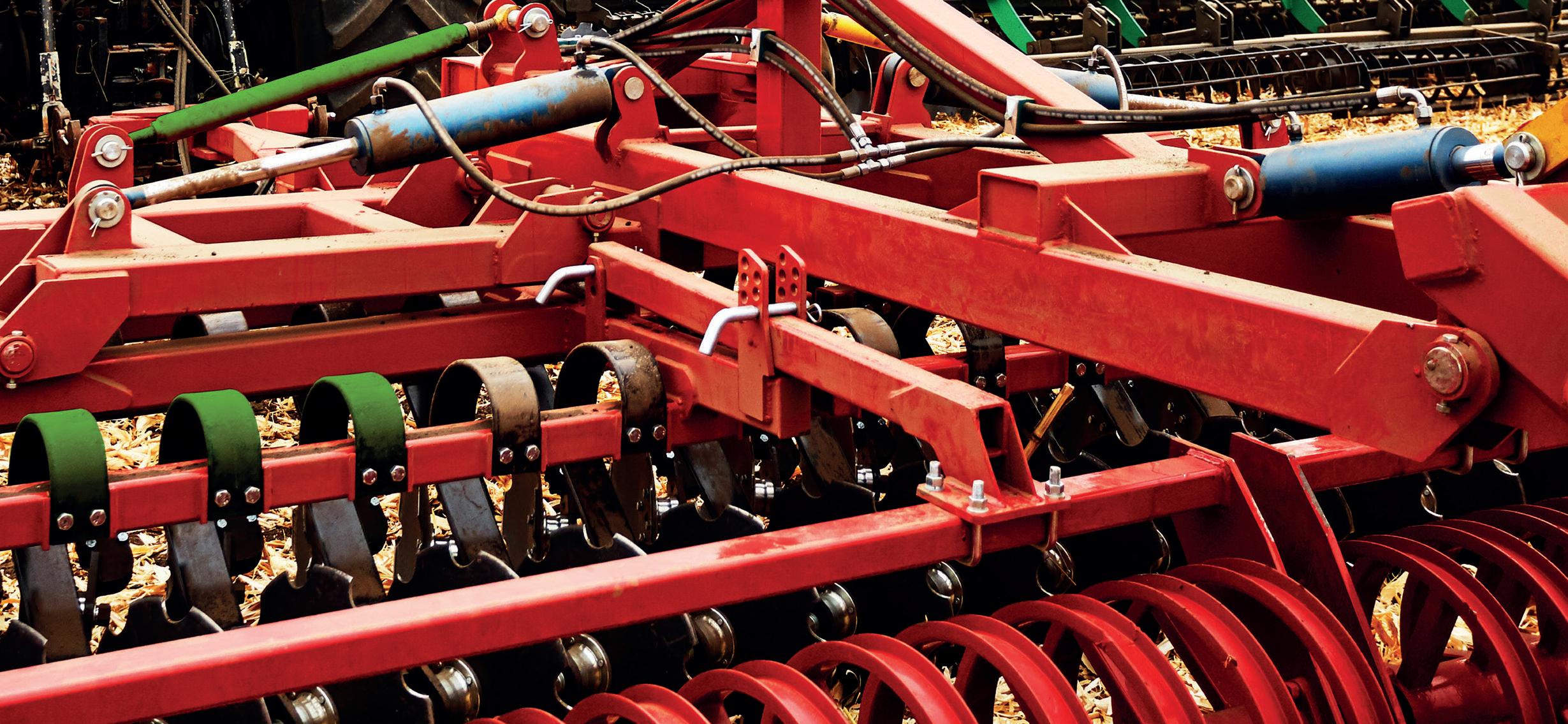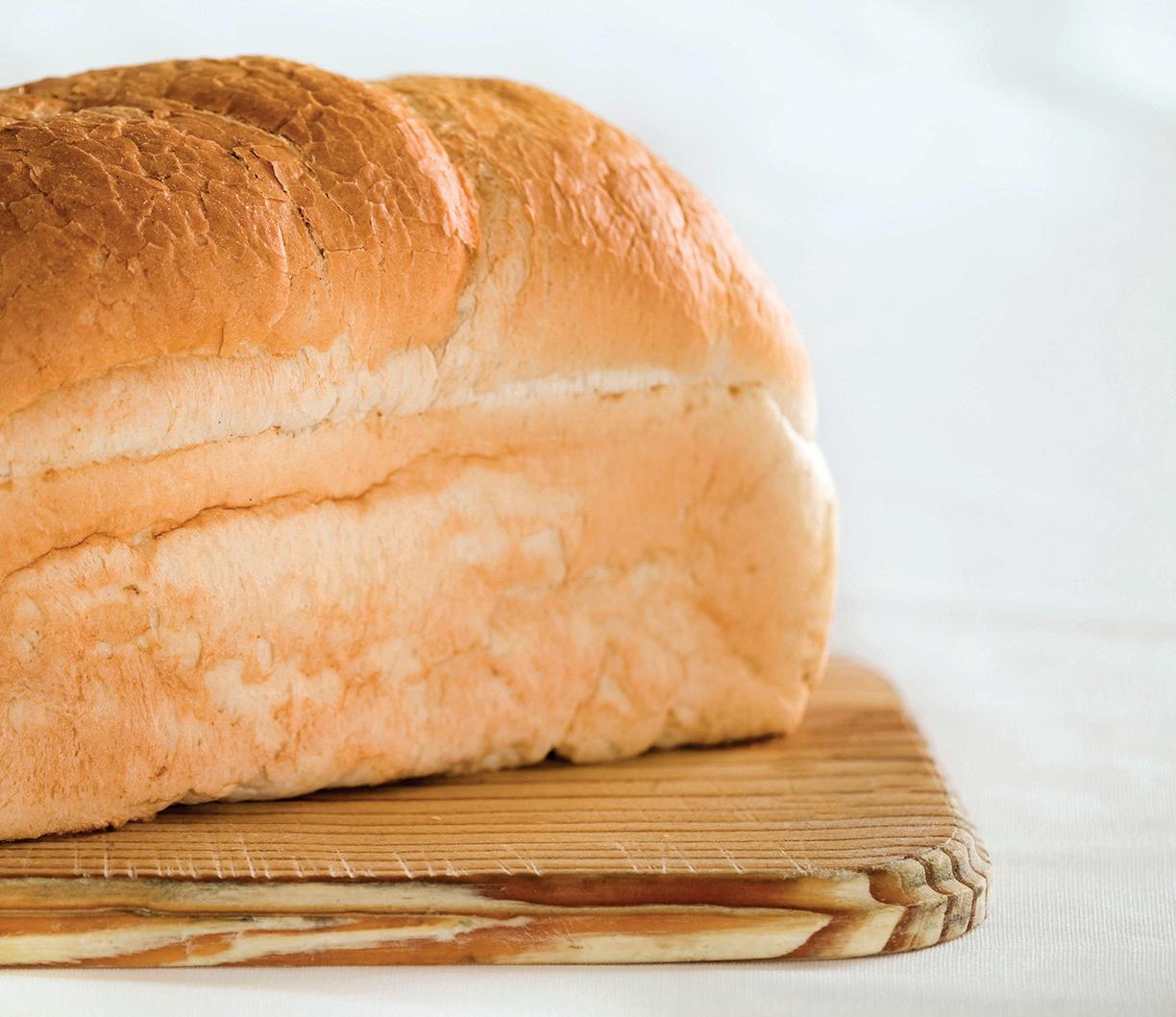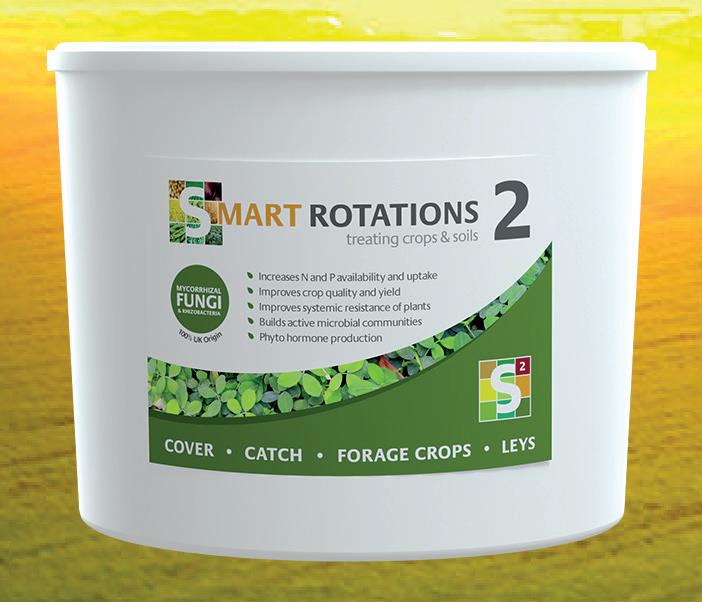
12 minute read
SPO sets out its aims for the seed potato sector
SPO sets out aims for seed sector
Visitors to Potatoes in Practice heard of plans for a new seed potato organisation and a potato innovation centre. Ewan Pate reports.
Proposals for a new industry body, to be known as the Seed Potato Organisation (SPO), took a step forward at Potatoes in Practice.
At the event, held at the James
Hutton Institute’s (JHI)
Balruddery Farm near Dundee, working group chair Mike
Wilson outlined a body which would have a GB remit on all matters relating to seed potato production and do it at cost of around £1 per tonne. Mr Wilson, who farms in Aberdeenshire, is also chair of NFU Scotland’s potato working group.
As with other bodies being promoted in the wake of the demise of AHDB Potatoes and
AHDB Horticulture, the organisers were keen to stress this would not be a levy body.
Instead, the plan is to work with
DR PHIL BURGESS
co-operative umbrella body the Scottish Agricultural Organisation Society to create a structure which would make sure the organisation was grower controlled.
Mr Wilson said: “It will be a case of one member, one vote, irrespective of size. Members will purchase a £1,000 shareholding and then pay an annual subscription based on area. The suggestion is this might be £29 per hectare.
“There is a possibility that we might have regional groups, for example in Yorkshire and Wales, and to have associate membership available for non-growers. The annual income we think will need to be around £400,000.”
Value
Dr Phil Burgess, of Scottish Potatoes.org – a liaison link between SAC Consulting and JHI, said: “We envision SPO as being run by growers for growers and providing value for money. It will represent growers’ views, fund research, support development and help secure long-term sustainability for the seed sector.”
One priority will be to take over the aphid monitoring service previously run by AHDB Potatoes and this year funded by Scottish Government.
Prof Gerry Saddler, chief executive of Science and advice for Scottish Agriculture (SASA), said he was ‘very enthusiastic’
International Potato Innovation Centre planned
JPlans have been unveiled for a new International Potato Innovation Centre (IPIC).
Costing an estimated £40 million, it will be constructed at the James Hutton Institute (JHI) Mylnefield Lipid Analysis laboratory and partner the International Barley Hub which is already under construction and is likely to be completed in 2024.
Prof Lesley Torrance, director of science at the institute, said: “There is a definite need for such a facility. Potato is the third most important staple food in the world and we urgently need varieties that can cope with climate change. There are
Also in this section
22 Optimising nutrition for milling wheat 24 IWM approach essential to hold black-grass control line 28 Black-grass control – as good as it gets? 34 Weed cutter showing potential in conventional crops 38 Per plant robot service launches to farms 42 Non-triazole option for LLS proves worth in trials 46 Farming for profit, people and the planet 50 Connect with confidence in the CropTec hubs major advances being made in all the technologies involved in potato production and as a major provider of research in the UK, JHI is well placed to take the lead.”
Genetic variation
New glasshouses will allow breeders to make the most of the genetic variation in the Commonwealth Potato Collection, which is already housed at JHI.
It is intended that there will be an industry-led approach to the work at the IPIC and that partnerships will be formed globally. The immediate challenge, however, is to raise enough funds to take the idea beyond the drawing board.
The IPIC is not the only major potato-related investment planned for the east of Scotland.
Funds have already been sourced from UK and Scottish Government under the Angus Cities Deal which will allow for a £15m allocation towards a Centre of Agricultural Sustainable Innovation.
This will likely be headquartered in the old Forfar Market building. Its potatorelated activities will, however, be centred round a Potato Quality Centre five miles away at Agrico UK’s premises at Castleton of Eassie.
SPO sets out aims for seed sector
Plans for new potato organisations and research facilities were unveiled at Potatoes in Practice, held in August at Balruddery Farm, near Dundee.

about the prospect of SPO taking on many of the functions of AHDB and reminded growers that the Scottish Government commitment to fund aphid monitoring and the Fight Against Blight programme was for one year only.
Mark Taylor, chair of the working group formed to set up GB Potatoes, said he did not see the two bodies as being in competition and that there was plenty of room for them to work together on projects such as securing approval for registering chemicals.
The SPO working group has set an initial target of signing up at least 50% of GB seed growers.

PCN threat
JPotato cyst nematode (PCN) is costing the seed potato sector £25 million per year, but unless the soil-borne pest is brought under control this figure could rise to £125m per year and ultimately cause the sector’s demise. The warning, issued at Potatoes in Practice, came from Prof Ian Toth, senior plant health scientist at the James Hutton Institute (JHI).
“It is a grave threat. We are losing about 5% of clean land in Scotland every year to PCN infection. In Angus, the main potato growing county, the loss is nearer 11%. The persistent pallida species has overtaken the rostochiensis species as the problem. Growers must keep fields clean if that rate of loss is to be halted and that means controlling groundkeepers,” he said.
Dr Phil Burgess, head of Scottish Potatoes.org, believed pallida-resistant varieties would play a key role in controlling the pest. There were six such varieties in the JHI plots at the event, but most were processing varieties. Breeders of table potatoes had given pallida resistance a lower priority over the years.
Eight work programmes are underway as part of the Scottish Government-funded PCN Action Scotland project, with trials taking place on a high PCN infestation site near Forfar. One of the mitigations involved incorporating compostcontaining chitins derived from seafood waste.
Importance
Prof Gerry Saddler, head of SASA, said Scottish Government was aware of the importance of the PCN Action Scotland programme. He had also been involved in discussions around lifting the ban on the export of seed potatoes from Scotland to the EU and Northern Ireland.
“I am aware that this is creating real hardship. The current situation is the UK Government is considering equivalence applications from several EU countries which would allow them to export seed potatoes to the UK. This is clearly unfair when trade in the other direction is not allowed to take place,” he said.


Proven Effective Dependable

cropscience.bayer.co.uk/roundup

PROVEN
n Cornerstone of grass-weed management n Rainfast from 1 hour n Excellent performance in challenging spring and
summer conditions
n Modern drift-minimising formulations
For further information, visit www.cropscience.bayer.co.uk/roundup, or call 0808 1969522 for technical enquiries. Roundup is a registered trademark of the Bayer Group. Roundup contains Glyphosate. USE HERBICIDES SAFELY. ALWAYS READ THE LABEL AND PRODUCT INFORMATION BEFORE USE. © 2022 Bayer Group. All rights reserved.
Optimising nutrition for milling wheat
Four years of field trials in an AHDB-backed research project* to help growers better meet UK millers’ needs have just been completed. Andrew Blake reports.
When it comes to wheat baking quality, it matters not whether the nitrogen applied to the crop is urea or ammonium nitrate.
That is one of several key points arising from research led by Dr Nathan Morris, NIAB senior specialist – farming systems and soils.
“There has been a perception in the industry that foliar urea is not considered suitable for baking quality wheats. Yet this isn’t the case given the results from this project,” says Dr Morris.
The work aimed to update guidance on using nitrogen and sulphur fertiliser on winter milling wheat to get optimum grain quality and milling specifications for leading breadmaking varieties grown under a range of soil types and environments.
Grain quality
The research was originally sought by nabim, now known as UK Flour Millers.
It evaluated the impact of N and S rates and timings on dough rheology and baking performance, including (for S) the production of asparagine.
The first stage was consulting widely to home in on exactly where the knowledge gaps were regarding winter milling wheat management, he says.
“This ultimately formed the basis of field trials.”
These were conducted across six sites from southern and eastern England to Scotland.
There were two trial series, the first looking at nitrogen application rates and timings, the second examining sulphur responses.
Both investigated the impact of fertiliser on grain yield, with post-harvest grain analysis recording properties including protein, specific weight and Hagberg falling number to identify treatments that met milling specification.
Samples meeting those specifications were also sent to the Allied Technical Centre to conduct pilot milling and test baking work.
Dr Morris says the project’s main messages are: Site and season have the greatest impact on grain quality, low spring rainfall having a substantial effect on nitrogen uptake and efficiency. August rainfall resulted in low Hagberg Falling Numbers or specific weights at some sites that would result in poor rheology and baking performance.
Grain protein increases where nitrogen (as ammonium nitrate or urea) is applied after

Project could be a ‘game changer’
JWhen the project began, independent adviser Alli Grundy says she was excited at the prospect of it shedding light on how milling wheat nutrition might be improved.
“The holy grail in my book is how the industry may more consistently increase the odds of achieving adequate grain protein season in and season out,” says Miss Grundy, who runs Cheshire-based Compass Agronomy.
Contribution
“Overall, the project outcomes make a valuable contribution to the practical guidance on nitrogen and sulphur and it highlights the impact of management strategies on grain processing, such as dough rheology and baking performance.
JobsInAgriculture Jobs in your field
Find Jobs Faster

Receive the latest jobs in your inbox with our free email alert service
Let us keep you updated by email and never miss another great job JobsInAgriculture.com
Optimising nutrition for milling wheat
AHDB-funded research has examined the impact of nitrogen and sulphur rates and timings on dough rheology and baking performance of winter milling wheat varieties.
growth stage 32-35. An extra 40kg N/ha is enough to raise grain protein for the desired specification for rheology and baking.
There was no detrimental impact on baking quality when foliar urea was applied instead of ammonium nitrate.
Where foliar urea was applied at GS73 there was a trend for the gluten to be stronger than

“Being confident that you’ve supplied enough nitrogen to the crop to satisfy both yield and grain quality is a major step forward.
“In the climate of high input prices, the current status quo is to apply additional nitrogen because current guidance suggests you should, without having a mechanism to check if it’s necessary.
“However, a new protein prediction analysis was examined in the project and seemed to pinpoint with reasonable certainty whether crops did or didn’t need the traditional final nitrogen application.
“This could be a game changer in managing nitrogen.
Not only does it make economic sense to apply it only if needed but, from an environmental perspective, we need to avoid loading the system with nitrogen that isn’t going to be used by the plant and is therefore at risk of being lost.

Perspective
“Revisiting the benefits of applying sulphur is also useful from an advisory perspective – particularly any new advice around changes to rate and timing.
“These practical outcomes are easily adopted by growers and are where potential productivity and quality gains can readily be made.” where only ammonium nitrate was applied.
There was little consistent evidence that sulphur doses above the currently recommended 50kg SO3/ha reduce grain asparagine levels.
The research threw up few surprises, admits Dr Morris.
“Extreme weather can have a big effect on crop establishment and the crop’s ability to take up and use nitrogen.
“So, growers should be mindful of the weather around the time of fertiliser applications and be ready to adapt their strategies accordingly.
“Similarly, attention at harvest to prioritise quality wheat crops if the forecast predicts rain to minimise the risk of reducing Hagberg Falling Numbers.
“The impact of high nitrogen fertiliser prices will clearly be at the forefront of growers’ minds and it’s important to consider the break-even ratio to ensure there’s an Project details

r*AHDB project 21140040 Nitrogen and sulphur fertiliser management to achieve grain protein quality targets of high-yielding winter milling wheat rJuly 2018 to July 2022 rLed by NIAB and partnered by SRUC rTotal cost: £230,998 (AHDB investment £179,548) rCollaborators (with in-kind contributions): Allied Technical Centre (£28,000); RAGT Seeds (£10,500); KWS UK (£4,200); Omex Agriculture (£3,750); Masstock Arable trading as Agrii (£3,500); AHDB (£1,500)
economic return from applications.
“Achieving grain quality specification that meets UKFM needs will be essential to achieve premiums on crops for milling.”
PLANTING COVER CROPS THIS SEASON?
Treat with SR2 Mycorrhizal Fungi & Rhizobacteria
Inoculate cover crops Improved growth and soil health Increased mycorrhizal levels for follow on crop
SR2 for application on cover crops, herbal leys and forage grass at a nominal rate of 10Kg/Hectare.
Available for mixing with seeds on farm, or pre blended by your seed supplier For further information: T:+44(0)1795 411527 M:+44(0)7990042473 natallia.gulbis@plantworksuk.co.uk smart.plantworksuk.co.uk










